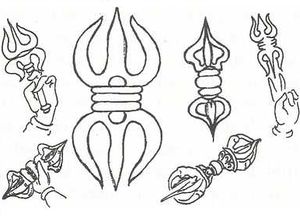Vajrāyudha
From Hindupedia, the Hindu Encyclopedia
By Swami Harshananda
Vajrāyudha literally means ‘the thunderbolt weapon’.
Vajrāyudha is the invincible weapon of Indra with which he killed many powerful asuras[1] like Vṛtra.
It is said to have been shaped out of the backbone of the sage Dadhīci by Viśvakarma, the architect of the gods.
References[edit]
- The Concise Encyclopedia of Hinduism, Swami Harshananda, Ram Krishna Math, Bangalore
By Swami Harshananda
Vāk literally means ‘speech’.
References[edit]
- The Concise Encyclopedia of Hinduism, Swami Harshananda, Ram Krishna Math, Bangalore

